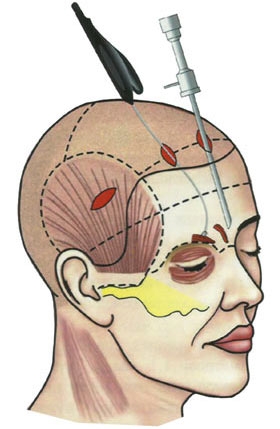Age-related changes in the skin of the face, so disturbing to many women, first of all are manifested by the formation of deep wrinkles on the forehead and drooping of the eyebrows. The most effective method used to correct this condition is surgical rejuvenation of the upper third of the face – fronto-temporal lifting. This operation is one of the most frequently performed in plastic surgery, so how a forehead lift is requested not only by older women, but also by young girls with anatomical features of the face, for example, with low eyebrows and heavy eyelids. The first description of a forehead lift is mentioned in the literature as early as 1919, which suggests that women from ancient times have resorted to any means to preserve the youth of the face and body.
What age-related changes in the skin force a forehead liftAge changes, necessarily occurring in the human body, are also displayed on the condition of the skin of the face. A forehead lift becomes necessary due to the following changes in the upper third of the face:
- under the influence of gravity, the lateral tails of the eyebrows, the lateral canthus, and the skin-fascial structures of the temporal region are gradually shifted down;
- the distance between the free edge of the upper eyelid and the eyebrows is shortened;
- by mm. corrugator, procerus and depressor supercilii glabella wrinkles form;
- True dermochalasis of the upper eyelids develops.
Fronto-temporal lifting is carried out by several methods and pursues clear goals, which are determined by a plastic surgeon on the basis of an objective analysis of the proportions and structural features of the patient's face, and with the obligatory consideration of her personal wishes. The main desired effects that forehead lift surgery is trying to achieve are:
- restoring the position of the eyebrows and eliminating the upper pseudodermachalasis;
- decreased activity of the mimic muscles of the glabella;
- correction of the position of the outer corners of the eyes;
- in case of insufficient expression of the fold of the upper eyelid – its formation;
- removal of areas of excess tissue of the frontal and temporal lobes, as well as excess skin of the upper eyelids.
All methods of performing fronto-temporal lifting can be divided into three more groups: open, closed and combined. An open or coronal lift is performed by making a large incision in the skin of the forehead and is recommended for patients over 40 who need to remove areas of excess skin. The main advantages of the open technique of fronto-temporal lifting include good visualization of the operated anatomical structures, the possibility of increasing the height of the forehead or reducing the hairline, if necessary, as well as the absence of the need to use special expensive equipment. At the same time, the invasiveness of the operation, the formation of a long postoperative scar,
Endoscopic fronto-temporal lifting: pros and cons of the technique
Today, endoscopic surgery for forehead lift is widely used – endoscopic fronto-temporal lifting. The operation is performed through several small incisions and is recommended for young patients with no need to excise excess skin. Minimal invasiveness of the operation, preservation of the sensitivity of the scalp, rapid recovery, invisible small scars are the undoubted advantages of this method of fronto-temporal lifting. The only drawback of the operation is the high cost, which is directly related to the need to use expensive endoscopic equipment.
Methodology and stages of closed front-temporal lifting
Endoscopic fronto-temporal lifting is carried out in several stages. Begin the operation by marking – determining the quantity and location sections of cuts. At the second stage, local anesthetic is injected and the incisions are made.

 How to avoid possible complications after a forehead lift
How to avoid possible complications after a forehead lift







Add a comment